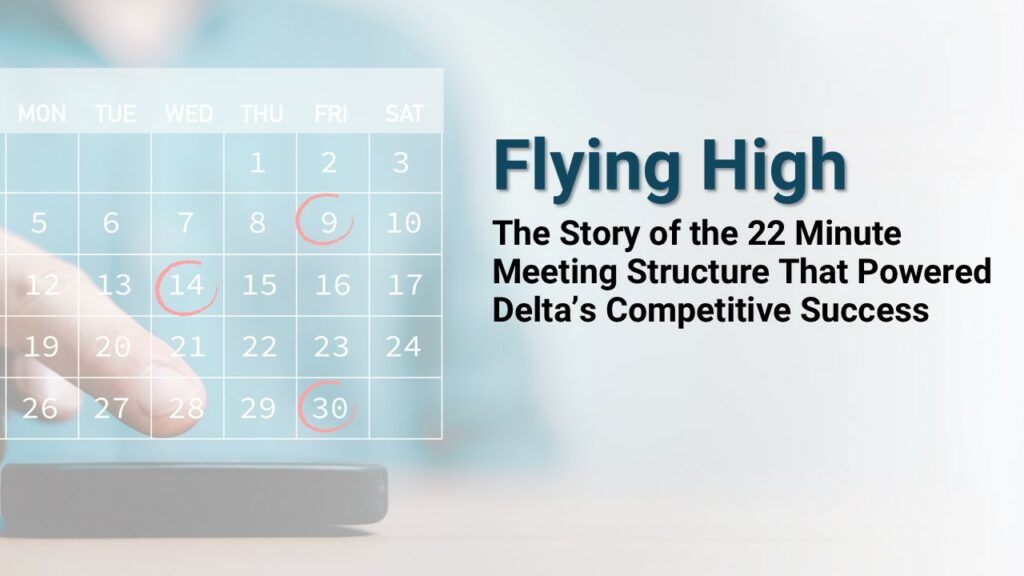In the summer of 1995, Delta Airlines received unwelcome news. Southwest Airlines had announced a major expansion of service to Florida to begin the following year, with a promise to reduce fares by 50 percent. At the time, Florida represented 30 percent of Delta’s revenues—revenues Delta could not afford to lose. Delta needed to do something.
Coming up with a competitive response, however, was no easy task. One option was to create a low-cost spinoff or subsidiary. It would be a challenge. Several full-service carriers had tried it already, and none had been successful. High operating costs, poor on-time performance, and a confusing customer product proved to be hurdles the legacy airlines couldn’t clear. Then there were the internal challenges. Each Delta department believed it knew what to do better than the others, and the company was in the middle of a cost-reduction initiative to boot.
Nevertheless, in early 1996, driven by the imperative to respond, a cross-functional team of Delta pilots, flight attendants, and representatives from marketing, sales, scheduling, maintenance, airport customer service, and airport operations met. Their objective? Develop a profitable, low-cost strategy that mitigated Southwest’s impact on Delta’s Florida market, and it had to be in place that fall.
Incredibly, the team pulled it off.
In only six months, the team moved from capturing ideas on Post-Its and flip-chart-covered walls to the transformation of a fleet of 33 newly branded 737-200s, a new set of customer service procedures, and innovative airport ground choreography to enable a 30-minute turnaround between flights. The resulting cost structure beat Southwest’s operating costs and also established a positive team culture that bubbled with pride for what everyone had accomplished.
Purposeful Meetings
As one of two members of the consulting group privileged to be part of that amazing feat, I could share many lessons from that experience. But for today—and building from last week’s blog—I want to focus on the effect that a deliberate meeting structure had on Delta’s successful outcome.
[People often ask me how frequently a team should meet. The answer is rather simple: You should meet as frequently as needed given the speed of the changes occurring in your initiative. Are you working on a project that moves at glacial speed? Great. Then let’s meet every thousand years to discuss progress. But if project information and decisions change weekly, then you had better meet on a more frequent schedule.]
When it came to setting Delta’s meeting frequency, team members faced an important trade-off. They needed to meet daily given the rapid changes occurring in their fast-track implementation schedule. They were also concerned, however, about spending too much time in meetings listening to irrelevant (to them) topics when so much needed to be done.
The answer? Meet daily but for no longer than 22 minutes, and no time would be spent developing or emailing agendas. Things were changing so quickly that any agenda created more than three hours in advance would be invalid.
The team set up a meeting room in an unoccupied area with large, mobile whiteboards to frame the space. Most of the company’s conference rooms had projection screens, but no whiteboards. One of the whiteboards had two permanent column headings: Info and Discuss. When team members arrived for the daily meeting, each grabbed an erasable marker and wrote their topic(s) to be covered under the appropriate heading. There were rules for topic placement.
Info and Discuss
Topics listed under the Info column were to be delivered in 60 seconds or less with no comments allowed. Clarification questions were welcome, but there could be no discussion of the updates’ merits. The information shared had to be relevant to other team members. You were cut off if you exceeded the 60-second mark. We soon added a rule that if there seemed to be a lot of passion around a given topic, we would move that topic to the Discuss column.
The Discuss column captured the topics that needed input from other team members. These conversations were limited to five minutes. The topic owner had to come prepared with a one-minute summary of the issue and the key questions that needed answering. Focus, focus, focus.
The final constraint? The meeting would last no more than 22 minutes. We intentionally chose that duration because we wanted to emphasize the importance of minutes and that brevity and focusing were desirable and expected behaviors. Challenged with the seemingly impossible task of turning out a profitable product in six months, there was no time for long-winded, self-serving, or irrelevant exchanges of opinion.
Flight Ready
Of course, there were some struggles at first. As the facilitator, I intervened (interrupted?)—a lot. People got cut off and redirected when their comments had no relevance or were too lengthy. The first couple or so meetings were tough.
But the talk became more focused and more precise. Other behaviors changed as well. The side comments decreased. Team members didn’t always feel compelled to comment on another’s actions. They learned to trust in the decisions others were making, even if they might have made another decision had it been up to them. The team caught on quickly. After two weeks, I no longer needed to facilitate. And the team got things done.
Wheels Up
What was the ultimate effect of that meeting structure? On October 1, 1996, six months after the first strategic planning session and ahead of the stated deadline, a Delta Express plane carrying 136 passengers (including several Delta employees who wanted to be part of the historic moment) departed from Boston and headed south toward Orlando. Delta Express achieved the lowest cost-per-seat mile in the industry and profitability within the first year. The biggest financial success, however, was that the mainline adopted many of the lessons learned—managing faster turnaround times, flight-attendant-driven customer initiatives, direct ticket sales and distribution, revenue management of ticket pricing, and alliances with Disney, Universal, and the Braves. The mainline’s adoption of these innovations likely accounts for a significant portion of Delta’s current growth and profitability.
Delta’s success is a testimony to what can be achieved when we deliberately limit our meeting’s duration and develop the discipline to use every minute wisely. Don’t take those minutes for granted!

